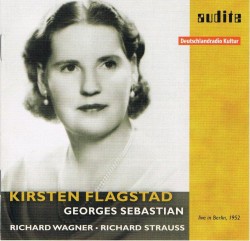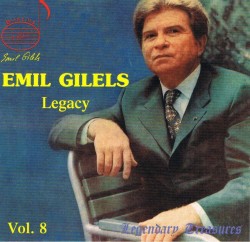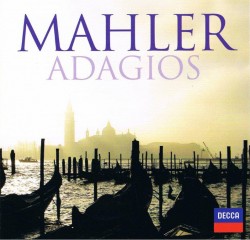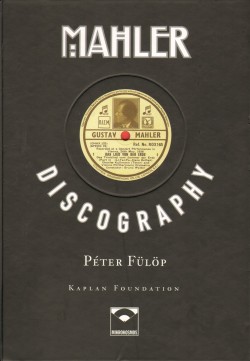 Following the Second World War the music world awaited the return of Kirsten Flagstad to the stage and recording studio. In the 1930s when the Metropolitan Opera had severe financial shortfalls, for six seasons Flagstad and Lauritz Melchior`s collaboration in various Wagner music dramas guaranteed SRO houses, contributing significantly to the Met`s survival. She came back in 1947 and in 1948 EMI began recording her in Wagner and others. In 1952 she recorded Tristan und Isolde with Wilhelm Furtwangler, produced by Walter Legge. Legge let it be known that his soon-to-be wife, Elizabeth Schwarzkopf had to sing some of the high notes - indiscrete and undiplomatic to say the least. On a new CD derived from Deutschlandradio tapes (Audite 23.416, 2 CDs) we hear Flagstad live in concert in Berlin on May 9 & 11 1952... exactly one month before the Tristan sessions began in London. In the autumn of her career, her voice was still characteristically rich, flexible, well focused and, yes, thrilling. The repertoire is Wagner and Richard Strauss, composers with whom she was associated throughout her long career: The Wesendonck-Lieder; Prelude, Isolde’s Narrative and Curse, and Liebestod from Tristan; and the Immolation scene from Gotterdammerung. Also three of The Four Last Songs (she omits “Im Frühling”) and Elektra’s monologue. The repertoire is taxing but she shows no fatigue or stress. While her delivery is not quite up to her glory days, the old artistry is still there, holding the listener’s attention in a satisfying matter. Admittedly she is favoured by the engineers, being closely miked and slightly prominent. In truth it is not a natural balance as one would hear in a live concert but certainly more pleasing to our ears. A rather small penalty is that the orchestra is sometimes too far in the background. Georges Sebastian conducts The Orchestra of the Municipal Opera, Berlin in the Titania Palace. A treasure if there ever was one.
Following the Second World War the music world awaited the return of Kirsten Flagstad to the stage and recording studio. In the 1930s when the Metropolitan Opera had severe financial shortfalls, for six seasons Flagstad and Lauritz Melchior`s collaboration in various Wagner music dramas guaranteed SRO houses, contributing significantly to the Met`s survival. She came back in 1947 and in 1948 EMI began recording her in Wagner and others. In 1952 she recorded Tristan und Isolde with Wilhelm Furtwangler, produced by Walter Legge. Legge let it be known that his soon-to-be wife, Elizabeth Schwarzkopf had to sing some of the high notes - indiscrete and undiplomatic to say the least. On a new CD derived from Deutschlandradio tapes (Audite 23.416, 2 CDs) we hear Flagstad live in concert in Berlin on May 9 & 11 1952... exactly one month before the Tristan sessions began in London. In the autumn of her career, her voice was still characteristically rich, flexible, well focused and, yes, thrilling. The repertoire is Wagner and Richard Strauss, composers with whom she was associated throughout her long career: The Wesendonck-Lieder; Prelude, Isolde’s Narrative and Curse, and Liebestod from Tristan; and the Immolation scene from Gotterdammerung. Also three of The Four Last Songs (she omits “Im Frühling”) and Elektra’s monologue. The repertoire is taxing but she shows no fatigue or stress. While her delivery is not quite up to her glory days, the old artistry is still there, holding the listener’s attention in a satisfying matter. Admittedly she is favoured by the engineers, being closely miked and slightly prominent. In truth it is not a natural balance as one would hear in a live concert but certainly more pleasing to our ears. A rather small penalty is that the orchestra is sometimes too far in the background. Georges Sebastian conducts The Orchestra of the Municipal Opera, Berlin in the Titania Palace. A treasure if there ever was one.
 The legend of Emil Gilels seems to intensify as the years go by even though he has now been gone for fifteen years. His recordings continue to emerge from time to time to the delight of his devotees around the world. However, it is the documents of concert performances that are most exciting to collectors. DOREMI, which has already released seven discs of predominantly rare live concerts performances, has an eighth CD devoted to early such live material from the 1950s and early 1960s (DHR-7920). In top shape, he is heard in spirited performances. A rarity among them is the Khachaturian Piano Sonata alongside the familiar Chopin Ballade no.1 which receives one of, if not the most moving performance in memory... a real find. I should mention the effervescent Polkas by Smetana and a sparkling Etude by Mendelssohn plus works by Pancho Vladigerov, Bartok, and Ravel. Good sound.
The legend of Emil Gilels seems to intensify as the years go by even though he has now been gone for fifteen years. His recordings continue to emerge from time to time to the delight of his devotees around the world. However, it is the documents of concert performances that are most exciting to collectors. DOREMI, which has already released seven discs of predominantly rare live concerts performances, has an eighth CD devoted to early such live material from the 1950s and early 1960s (DHR-7920). In top shape, he is heard in spirited performances. A rarity among them is the Khachaturian Piano Sonata alongside the familiar Chopin Ballade no.1 which receives one of, if not the most moving performance in memory... a real find. I should mention the effervescent Polkas by Smetana and a sparkling Etude by Mendelssohn plus works by Pancho Vladigerov, Bartok, and Ravel. Good sound.
 The emotional resonance of the Adagietto from Mahler’s Fifth Symphony makes it one of the most familiar pieces in the 20th century repertoire, thanks in no small way to its importance on the soundtrack of Visconti’s 1971 masterpiece, Death in Venice. The general public responded to the serenity of the Adagietto and were offered similarly calming pieces such as the Pachelbel Canon and Albinoni’s Adagio. A new compilation, Mahler Adagios (Decca 4782342, 2 CDs) contains adagios from Mahler’s symphonies three, four, five, six and nine in addition to - now these are master-stokes - Urlicht from the Second Symphony (Mira Zakai), “Der Abschied” from Das Lied von der Erde (Yvonne Minton), and “Ich bin der Welt abhanden gekommen” from the Rückert-Lieder. Sir Georg Solti and the Chicago Symphony are responsible for all but the Rückert-Lieder which has Brigitte Fassbaender accompanied by the Deutsches Symphonie, Berlin under Riccardo Chailly. Highly recommended to those new to the repertoire and those who are not.
The emotional resonance of the Adagietto from Mahler’s Fifth Symphony makes it one of the most familiar pieces in the 20th century repertoire, thanks in no small way to its importance on the soundtrack of Visconti’s 1971 masterpiece, Death in Venice. The general public responded to the serenity of the Adagietto and were offered similarly calming pieces such as the Pachelbel Canon and Albinoni’s Adagio. A new compilation, Mahler Adagios (Decca 4782342, 2 CDs) contains adagios from Mahler’s symphonies three, four, five, six and nine in addition to - now these are master-stokes - Urlicht from the Second Symphony (Mira Zakai), “Der Abschied” from Das Lied von der Erde (Yvonne Minton), and “Ich bin der Welt abhanden gekommen” from the Rückert-Lieder. Sir Georg Solti and the Chicago Symphony are responsible for all but the Rückert-Lieder which has Brigitte Fassbaender accompanied by the Deutsches Symphonie, Berlin under Riccardo Chailly. Highly recommended to those new to the repertoire and those who are not.
 The proportion of Mahler lovers among classical music fans has been steadily on the increase both in the concert halls and on recordings. Some avid collectors attempt to acquire every recorded version of every opus. There is no such thing as too many. They will no doubt be surprised to discover the enormous number of recordings documented in the second edition of the authoritative, absolutely comprehensive Mahler discography published by Mikrokosmos (ISBN 723721 481353). This hard cover, 568 page book is printed on glossy stock with many colour plates, and it is fully indexed by work, artist and ensemble and gives timings for every movement or section of every work. The editor, Pèter Fülöp has devoted over forty years to extensive research and detective work in order to acquire, successfully, every Mahler recording ever made. By far the most comprehensive book every published on the subject, this is a reference work, not a critique but an invaluable tool for the really serious collector. Recording dates, venues, and subsequent incarnations are included. The purchaser will find a CD restoration of the most elusive of all Mahler recordings of which only one copy is known to exist, the Fourth Symphony played by the Hilversum Radio Orchestra conducted by Paul van Kempen on December 28, 1949. For the moment, the book is available only from www.mikrokosmos.com.
The proportion of Mahler lovers among classical music fans has been steadily on the increase both in the concert halls and on recordings. Some avid collectors attempt to acquire every recorded version of every opus. There is no such thing as too many. They will no doubt be surprised to discover the enormous number of recordings documented in the second edition of the authoritative, absolutely comprehensive Mahler discography published by Mikrokosmos (ISBN 723721 481353). This hard cover, 568 page book is printed on glossy stock with many colour plates, and it is fully indexed by work, artist and ensemble and gives timings for every movement or section of every work. The editor, Pèter Fülöp has devoted over forty years to extensive research and detective work in order to acquire, successfully, every Mahler recording ever made. By far the most comprehensive book every published on the subject, this is a reference work, not a critique but an invaluable tool for the really serious collector. Recording dates, venues, and subsequent incarnations are included. The purchaser will find a CD restoration of the most elusive of all Mahler recordings of which only one copy is known to exist, the Fourth Symphony played by the Hilversum Radio Orchestra conducted by Paul van Kempen on December 28, 1949. For the moment, the book is available only from www.mikrokosmos.com.
 Seiji Ozawa celebrates his 75th birthday this month and Decca has issued an anniversary package containing outstanding performances of 14 works that show him at his best (4782358), 11 CDs in slimline box, specially priced. Although I am not an admirer of his way with Beethoven, Brahms and others, this set is pretty well devoted to works he does very well: Bartok, Berlioz, Ravel, Takemitsu, Mahler, Bach, Poulenc, Rimsky-Korsakov, Richard Strauss, Tchaikovsky, Wagner, Prokofiev and Bernstein. The orchestras are the Saito Kinen Orchestra, The San Francisco Symphony, The Boston Symphony, The Vienna Philharmonic, The Berlin Philharmonic and the Tanglewood Festival Chorus. Incidentally, all the Saito Kinen recordings, Bartok, Berlioz, Ravel, Takemitsu, are stunning, both in performance and for demonstration quality sound. The timpanist is the unmistakeable Everett Firth, recruited by Ozawa from Boston.
Seiji Ozawa celebrates his 75th birthday this month and Decca has issued an anniversary package containing outstanding performances of 14 works that show him at his best (4782358), 11 CDs in slimline box, specially priced. Although I am not an admirer of his way with Beethoven, Brahms and others, this set is pretty well devoted to works he does very well: Bartok, Berlioz, Ravel, Takemitsu, Mahler, Bach, Poulenc, Rimsky-Korsakov, Richard Strauss, Tchaikovsky, Wagner, Prokofiev and Bernstein. The orchestras are the Saito Kinen Orchestra, The San Francisco Symphony, The Boston Symphony, The Vienna Philharmonic, The Berlin Philharmonic and the Tanglewood Festival Chorus. Incidentally, all the Saito Kinen recordings, Bartok, Berlioz, Ravel, Takemitsu, are stunning, both in performance and for demonstration quality sound. The timpanist is the unmistakeable Everett Firth, recruited by Ozawa from Boston.



